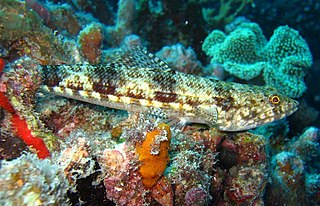
Aulopiformes is a diverse order of marine ray-finned fish consisting of some 15 extant and several prehistoric families with about 45 genera and over 230 species. The common names grinners, lizardfishes and allies, or aulopiforms are sometimes used for this group. The scientific name means "Aulopus-shaped", from Aulopus + the standard fish order suffix "-formes". It ultimately derives from Ancient Greek aulós + Latin forma, the former in reference to the elongated shape of many aulopiforms.

Enchodus is an extinct genus of aulopiform ray-finned fish related to lancetfish and lizardfish. Species of Enchodus flourished during the Late Cretaceous, and there is some evidence that they may have survived to the Paleocene or Eocene; however, this may just represent reworked Cretaceous material.
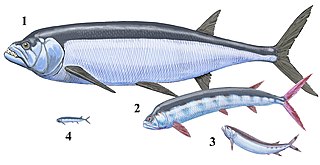
Ichthyodectiformes is an extinct order of marine stem-teleost ray-finned fish. The order is named after the genus Ichthyodectes, established by Edward Drinker Cope in 1870. Ichthyodectiforms are usually considered to be some of the closest relatives of the teleost crown group.

Cimolichthys is an extinct genus of large predatory marine aulopiform fish known worldwide from the Late Cretaceous. It is the only member of the family Cimolichthyidae.
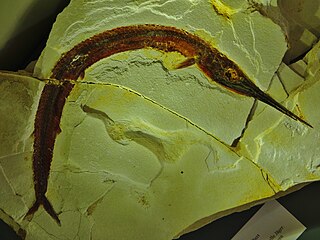
Aspidorhynchiformes is an extinct order of ray-finned fish. It contains only a single family, the Aspidorhynchidae. Members of the group are noted for their elongated, conical rostrums, of varying length, formed from fused premaxillae. The range of the group extends from the Middle Jurassic to the late Paleocene.
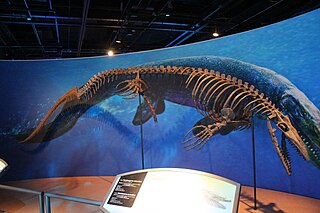
Taniwhasaurus is an extinct genus of mosasaurs that lived during the Campanian stage of the Late Cretaceous. It is a member of the subfamily Tylosaurinae, a lineage of mosasaurs characterized by a long toothless conical rostrum. Two valid species are attached to the genus, T. oweni and T. antarcticus, known respectively from the fossil record of present-day New Zealand and Antarctica. Two other species have been nominally classified within the genus, T. 'capensis' and T. 'mikasaensis', recorded in present-day South Africa and Japan, but their attribution remains problematic due to the fragmentary state of their fossils. The generic name literally means "taniwha lizard", referring to a supernatural aquatic creature from Māori mythology.

Apateodus is a genus of prehistoric marine ray-finned fish which was described by Woodward in 1901. It was a relative of modern lizardfish and lancetfish in the order Aulopiformes, and one of a number of prominent nektonic aulopiforms of Cretaceous marine ecosystems.
Bullichthys is an extinct genus of marine albuliform fish which existed in the Romualdo Formation, Brazil during the Early Cretaceous (Albian) period. The type species is B. santanensis. The genus name references its inflated otic bulla.

Callipurbeckia is an extinct genus of marine semionotiform ray-finned fish from the Late Jurassic and Early Cretaceous periods. Fossils have been found in Germany, Tanzania, and England.
The Sierra Madre Formation is a geologic formation in Chiapas state, southern Mexico. It consists of marine dolomites and limestones. The formation dates to the Middle Cretaceous, spanning from the Aptian of the Early to the Cenomanian of the Late Cretaceous.
This list of fossil fishes described in 2016 is a list of new taxa of jawless vertebrates, placoderms, acanthodians, fossil cartilaginous fishes, bony fishes and other fishes of every kind that have been described during the year 2016, as well as other significant discoveries and events related to paleontology of fishes that occurred in the year 2016. The list only includes taxa at the level of genus or species.

Kaikaifilu is an extinct genus of large mosasaurs that lived during the Late Cretaceous (Maastrichtian) in what is now northern Antarctica. The only species known, K. hervei, was described in 2017 from an incomplete specimen discovered in the López de Bertodano Formation, in Seymour Island, Antarctic Peninsula. The taxon is named in reference to Coi Coi-Vilu, a reptilian ocean deity of the Mapuche cosmology. Early observations of the holotype classify it as a member of the subfamily Tylosaurinae. However, later observations note that several characteristics show that this attribution is problematic.
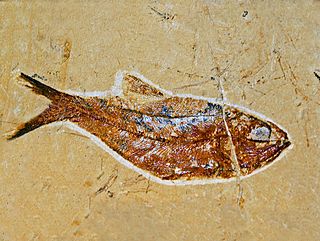
Armigatus is an extinct genus of marine clupeomorph fishes belonging to the order Ellimmichthyiformes. These fishes lived in the Cretaceous ; their fossil remains have been found in Mexico, southern Europe, the Middle East and North Africa, suggesting the genus ranged across the Tethys Sea.
This list of fossil fishes described in 2019 is a list of new taxa of jawless vertebrates, placoderms, acanthodians, fossil cartilaginous fishes, bony fishes, and other fishes of every kind that were described during the year 2019, as well as other significant discoveries and events related to paleoichthyology that occurred in 2019.
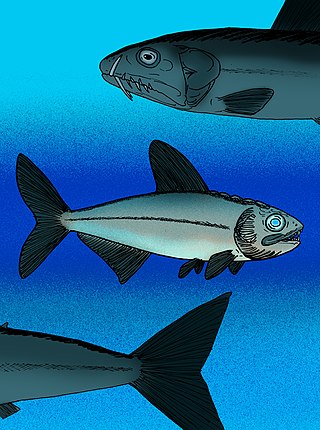
Veridagon avendanoi is an extinct aulopiform ray-finned fish related to species of Enchodus from the Cenomanian-aged Cintalapa Formation, exposed in El Chango Quarry, Chiapas, Mexico. Its original generic name was Dagon; however, this name was preoccupied by a group of South American butterflies. The generic name was eventually amended to Veridagon.
This list of fossil fishes described in 2020 is a list of new taxa of jawless vertebrates, placoderms, acanthodians, fossil cartilaginous fishes, bony fishes, and other fishes of every kind that were described during the year 2020, as well as other significant discoveries and events related to paleoichthyology that occurred in 2020.

The Dercetidae are an extinct family of aulopiform fish that are known from the Late Cretaceous to the Paleocene. They are among the many members of the diverse, extinct suborder Enchodontoidei, which were dominant during the Cretaceous. Many genera evolved a very slender body plan with elongated jaws, closely converging on modern needlefish.
Ichthyotringidae is an extinct family of aulopiform fish known from the Early to Late Cretaceous. It is one of the Enchodontoidei, a diverse group of aulopiforms that were dominant marine fish during the Cretaceous.

Halecidae is an extinct family of aulopiform fish known from the Cretaceous. It is one of the Enchodontoidei, a diverse group of aulopiforms that were dominant marine fish during the Cretaceous.

The Enchodontoidei are an extinct superorder of aulopiform fish known from the Early Cretaceous to the Eocene. They were among the dominant predatory marine fish groups in the Late Cretaceous, achieving a worldwide distribution. They were an extremely diverse group, with some developing fusiform body plans whereas others evolved elongated body plans with long beaks, superficially similar to eels and needlefish. They could also grow to very large sizes, as seen with Cimolichthys and Stratodus, the latter of which is the largest aulopiform known. Their most famous member is the widespread, abundant, and long-lasting genus Enchodus.














